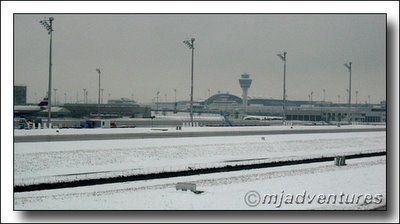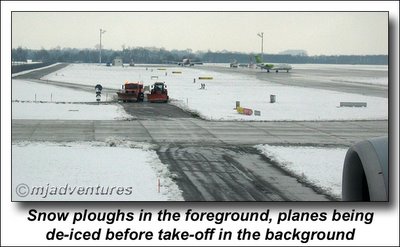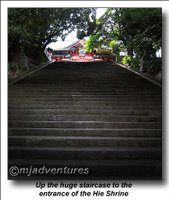 We're in Tokyo until Saturday afternoon on business. Thankfully, yesterday was a holiday here - Thanksgiving Day. It's not like the USA holiday - it's about giving thanks to the bread-winners in the family: those who pay the bills. We were thankful too - it gave us a day off!
We're in Tokyo until Saturday afternoon on business. Thankfully, yesterday was a holiday here - Thanksgiving Day. It's not like the USA holiday - it's about giving thanks to the bread-winners in the family: those who pay the bills. We were thankful too - it gave us a day off!
We walked around in the sunshine; found a great place to sit in the sun and read our books for an hour, before meeting with our office director here in Tokyo. W e also walked through our favourite shrine right next door to the hotel - the Hie Shrine. The shrine is a Shinto place of worship, and its history has been marked with violence: the buildings have been burned down twice, but the place is still so calm and peaceful and we love it.
e also walked through our favourite shrine right next door to the hotel - the Hie Shrine. The shrine is a Shinto place of worship, and its history has been marked with violence: the buildings have been burned down twice, but the place is still so calm and peaceful and we love it.
Today was a work day, and we had 3 meetings stretched far and wide across the city. I love Tokyo - the people are so polite and moving around the city is relatively easy with the fantastic rail system. We use it a lot to get from meeting to meeting, so we see a lot of cool sights. The people are a mix - older women sometimes in kimonos; lots of businessmen; young guys trying to be hip; young women who look like dolls, or dress in Hello Kitty gear! Short miniskirts and knee-high boots never go ou t of fashion with the women! Some of the schoolkids riding the trains don't look old enough to be in school, yet here they are navigating the train system with the experience of people 5 times their age. They are so cute in their uniforms and hats!
t of fashion with the women! Some of the schoolkids riding the trains don't look old enough to be in school, yet here they are navigating the train system with the experience of people 5 times their age. They are so cute in their uniforms and hats!
Tomorrow, we have more meetings and a press conference with one of our partners to announce a new product that they've integrated with our software.
On Saturday, we hope to get time to visit our favourite store in Tokyo - Bic Camera - if you clicked on this link, the store posters look like this too! 8 floors of electronics goods of every variety, and camera equipment to drool over. English-speaking shop assistants are scarce, but we manage. After all, we can't speak Japanese either, but a smile and a bow gets you a long way!
 A couple of weekends ago, we went to the Emirate of Fujairah on the east coast of the UAE for a spot of diving. As the dhow was due to leave Dibba Harbour on the Omani side at an early hour on Friday, we drove over on Thursday night.
A couple of weekends ago, we went to the Emirate of Fujairah on the east coast of the UAE for a spot of diving. As the dhow was due to leave Dibba Harbour on the Omani side at an early hour on Friday, we drove over on Thursday night.
We stayed at the Sandy Beach Hotel which was comfortable and had a good restaurant. The only downer was the amount of disinfectant that they used to clean the rooms - the smell left us with a headache akin to a mild hangover when we woke in the morning!
Early on Friday we boarded the dhow, and were soon out of the harbour and cruising on a smooth sea - north towards the Strait of Hormuz. After a couple of hours of motoring, and having the luck of a solitary dolphin riding the bow wave, the dhow made its way around the point between Limah Rock and the mainland. We anchored in the shelter of the point with the town of Limah in the distance.
The divers transferred onto the smaller and faster dive boat tender, and we were soon rocketing back towards Limah Rock to do the first dive of the day on the South Wall. Over the side we went, into a cool sea with visibility that wasn't the best, as there was a lot of plankton. It got better as we got deeper, and at around 20m, we were able to see about 15m around us.

The dive was an interesting one - lots of eels, coral formations and fish of all varieties including some territorial hammour. M was diving for the first time with her new underwater housing for her Canon camera and was keen to try it out. As the visibility was not that great with all the sediment in the water, the images were all closeups. The eels were very obliging and posed beautifully, the clown fish were a bit concerned that their space was being invaded, and the lion fish couldn't have cared less!

After an hour, we surfaced to be picked up by the dive tender and taken back to the dhow, where the crew had laid out the most delicious lunch which was devoured by the hungry divers.
The next dive was in the next southern bay on a site called Wonder Wall. Here, as well as eels and fish, we saw resting stingrays and the most enormous porcupine fish that allowed M to swim beside it and actually stroke it! It was totally unafraid, and swam around M for a while before heading off into the deep.
This dive was spectacular because of the rock formations underwater. It was a great experience to swim around a big rock and be surrounded by big schools of fish.
Another hour passed quickly by and after being picked up by the tender, we sped of f in pursuit of the dhow that had started back to Dibba. We caught up with it in a quiet and calm bay and transferred over, making way under a rising moon and with dusk quickly falling. It was truly beautiful to watch the light fading over the rugged Hajjar mountain range, and see the twinkling lights of Dibba come ever closer.
f in pursuit of the dhow that had started back to Dibba. We caught up with it in a quiet and calm bay and transferred over, making way under a rising moon and with dusk quickly falling. It was truly beautiful to watch the light fading over the rugged Hajjar mountain range, and see the twinkling lights of Dibba come ever closer.
It was a great day, and we met some wonderfully nice people onboard - it was great to spend time with interesting folk and learn more about life from their experiences.
We stayed another night at the Sandy Beach Hotel, as the next day we were going to travel back to Dubai on the gravel road via Oman and Ras Al Kaimah - but that's another story that will be told later!
The weird, wacky weekend weather that hit the Emirates over the past 2 days brought freak winds on Friday lasting for about an hour, and then rain on Saturday. Not heavy rain, and not for very long, but enough to count as rain in the UAE.
The Dubai Air Show is on this week, and this brings a lot of people to town. Certainly there are the plane enthusiasts, but more importantly, there is a heavy business and military presence. Bigwigs from all over the world congregate at major airshows such as the Dubai show to look at what's new, who's offering the best bargains (bribes), and in front of myriads of press cameras, they sign up to purchase aircraft.

Between the rain showers early on Saturday morning, Emirates Airlines showed off their latest acquisition - the Airbus A380. It paraded along the beach in front of the Burj al Arab and Jumeirah Beach Hotel for about an hour, with the pilot putting it through its paces as he banked the plane into turns around the Burj, and displayed the enormous Emirates logo painted on the underneath of the massive fuselage.
 Later in the afternoon, we were treated to a fly-past of another new plane for Emirates - the Boeing 777 - for which Emirates placed a US$9 billion order for about 40 planes with an option on 20 more. It only flew past once but, from what we could see, it wasn't as manoeuverable as the Airbus, and the turning circle appeared to be a lot wider.
Later in the afternoon, we were treated to a fly-past of another new plane for Emirates - the Boeing 777 - for which Emirates placed a US$9 billion order for about 40 planes with an option on 20 more. It only flew past once but, from what we could see, it wasn't as manoeuverable as the Airbus, and the turning circle appeared to be a lot wider. 
The best entertainment came from a little Lear (or similar) jet that was flying with the 2 aircraft. It was having a great time chasing the bigger jets through the sky, and flying alongside them as they passed down the beach. It was probably a film crew filming footage for future Emirates' ads, but we had more fun imagining that it was Sheikh Mohammed checking out his latest big boy's toys!
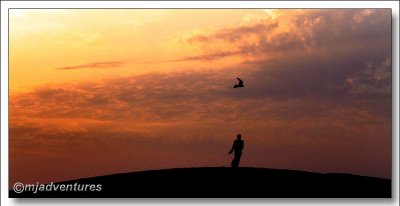 With the recent spate of visitors flowing through our place, we’ve been exploring places far and wide in our efforts to be entertaining hosts, and to allow our guests to see more than the metropolis of Dubai.
With the recent spate of visitors flowing through our place, we’ve been exploring places far and wide in our efforts to be entertaining hosts, and to allow our guests to see more than the metropolis of Dubai.
Although it’s a recent and modern facsimile of a fortified desert dwelling, the Bab Al Shams Desert Resort & Spa gets our vote as a place to take people to get a 'refined' feeling for the desert.
If timed for 30mins before sunset, the 45min drive from the SZR Interchange #4, p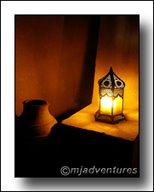 ast the Autodrome and heading for the Endurance Village through the desert, is a goody. Watching the sands turn golden red as the sun sinks is a major hit. We're puzzled by the speed limit on this road - 80kph – what’s with that? Plus, as you reach the T-junction and turn right, the plethora of speed cameras is enough to give the brakes a good workout, as yet another and another of the dang things come into view. On the last visit during Eid Al Fitr, with Aussie friend Terri, we were cruising along at 100kph and were passed by the Bab Al Shams courtesy coach doing 125kph, so we happily followed it to the hotel. Obviously none of the cameras were activated, and the driver knew it!
ast the Autodrome and heading for the Endurance Village through the desert, is a goody. Watching the sands turn golden red as the sun sinks is a major hit. We're puzzled by the speed limit on this road - 80kph – what’s with that? Plus, as you reach the T-junction and turn right, the plethora of speed cameras is enough to give the brakes a good workout, as yet another and another of the dang things come into view. On the last visit during Eid Al Fitr, with Aussie friend Terri, we were cruising along at 100kph and were passed by the Bab Al Shams courtesy coach doing 125kph, so we happily followed it to the hotel. Obviously none of the cameras were activated, and the driver knew it!
The hotel is very attractive – and it’s fun to wander through looking at all the interesting features that have been artfully designed to appeal to avid photographers.
The biggest attraction is the Al Hadheera Desert Restaurant which is a meandering 5 minute walk from the hotel along a winding paved pathway. Nestled behind sand dunes, it resembles a fortified town, and upon entering the gate you can’t help but smile and be in a good mood. The dining area is a mix of tables, benches and sunken dug-out seating areas, and the whole area is carpeted in rugs laid over the sand. My first impulse is to kick off my shoes and wander barefoot. The food serving area is set up like a food souk, and the chefs are keen for you to try their specialties. There’s a market-like feeling as they call out to you, enticing you with their culinary offerings. Although pricey, it’s a great experience to sit out in the open air under glittering stars, listening to music played by a live band, and eating delicious food. If you’re not careful, you’re full after the entrée, and there is deep compulsion to sink back into the huge cushions for a quick nap between courses.
My first impulse is to kick off my shoes and wander barefoot. The food serving area is set up like a food souk, and the chefs are keen for you to try their specialties. There’s a market-like feeling as they call out to you, enticing you with their culinary offerings. Although pricey, it’s a great experience to sit out in the open air under glittering stars, listening to music played by a live band, and eating delicious food. If you’re not careful, you’re full after the entrée, and there is deep compulsion to sink back into the huge cushions for a quick nap between courses.
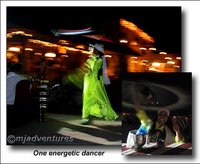 On our visits, there has been a very entertaining dancer who is incredibly energetic. On one occasion, he was the front half of a dancing horse that made its way from table to table greeting the guests. On another, he resembled a whirling Dervish as he twirled around and around on stage for at least 2 full songs. I don’t know how he did it, and why he didn’t fall over after he finished. His pièce de résistance is to come into the diners to get the women on the tables to try on the skirt and – literally – give it a whirl. J was chosen, and managed a very credible 3 spins in the heavy garment, until gravity made her stop before it all came to a sticky end!
On our visits, there has been a very entertaining dancer who is incredibly energetic. On one occasion, he was the front half of a dancing horse that made its way from table to table greeting the guests. On another, he resembled a whirling Dervish as he twirled around and around on stage for at least 2 full songs. I don’t know how he did it, and why he didn’t fall over after he finished. His pièce de résistance is to come into the diners to get the women on the tables to try on the skirt and – literally – give it a whirl. J was chosen, and managed a very credible 3 spins in the heavy garment, until gravity made her stop before it all came to a sticky end!
Out the back of the restaurant is an area where there are animals for the children to pat, and you can even go for a horse or camel ride.
The drive home in the darkness is always very quiet, as the passengers either nod off to sleep, or sit in quiet contemplation. It’s one of our favourite ‘touristy’ Arabian experiences – a great night out.

Today's Gulf News website has a report with photo on a former Dubai resident who was "outraged when she spotted a tiger looking out of a 4x4 while on holiday in the city."
Who was on holiday - the former resident or the tiger?! Ah - the vagaries of the English language!
The article goes on to say that Finn, Adele Kofler, then wrote to the World Society for the Protection of Animals to see what could be done about it.
The demise of endangered species, such as tigers, has a common enemy: man - through his greed and stupidity. A dead adult tiger can be worth as much as US$50k with the head, skin, claws, meat, blood and p*nis all being valued for trophy or medicinal purposes.
We watched a program on National Geographic on the tigers in a reserve in Ranthambhore, Rajasthan in India. It tracked some of the resident tigers, as well as described how the reserve rangers watch over them, but obviously they didn't watch them that well.
Sadly, the 18 or so tigers which were in that reserve have now "disappeared" – as have tigers in other reserves, such as Sariska National Park also in Rajasthan. An article on the Debating India website has tiger population figures that show the alarming rate of decline in numbers over the past century.
The tiger’s plight is certainly not helped by sheer idiocy in Baghdad in 2003, and if I had been there, it wouldn't have been the tiger who was shot.
All seriousness aside for a minute, wouldn’t it be very cool to drive down SZR with a tiger hanging out of your car? I wonder what the impact would be on the Sunny and Echo drivers!
The Gulf News also reports here on a new zoo for Dubai.
That's a positive move, and if there is one project that they should fast-track, it has to be this one.
Covering over 200 hectares, the first 50 hectares of the new zoo will be ready in 2008. That makes me wonder when the other 150+ are going to be completed, and when will the animals finally get some quality enclosures?
In the meantime, it would be great if the Dubai Municipality would temporarily move some of the poor creatures over to the Al Ain Zoo while their new residence is being built.
That would be a win-win for everyone - the Dubai Zoo would be less cramped for the remaining animals, the Al Ain Zoo would benefit from having creatures populating their empty enclosures, and the animals and their keepers would surely be happier in more spacious surroundings than what they are presently having to endure.
It would make a great day outing to Al Ain - where entry into their zoo is 2 Dirhams per adult - kids are free.
Animals and cramped concrete cages don't belong together.
The Gulf News has stooped to promoting Tabloid journalism articles on the Homepage.
Their website article Celeb wave sweeps Dubai had me chuckling at the list of "celebs" that are pouring into Dubai.
It's hardly an A-list, is it? Or a B or a C. Especially when they have to resort to mentioning old has-been English comedians, aging rock bands and Bollywood stars "shaking their legs and their booties". Don't forget the Shaolin Monks, who everyone knows on a first-name basis.
The article closes by urging the public to email the GN and relate their "close encounter of the celebrity kind". They list a very appropriate email address to do this.
What's next - a Page 3 girl?
Tragic.
As you do when any visitors come to town to stay, you take them to places that sometimes you've never seen either. Such as when M's parents were in Dubai for 2 weeks, and we took them to the Emirates Palace at the western end of the Corniche in Abu Dhabi which is the capital city of the UAE.
Run by the Kempinski Hotels management, (the same company with hotels in Ajman and a new one about to opened at the Mall of the Emirates), this amazing place really has to be experienced to be believed. No expense has been spared to make this an iconic landmark on the Abu Dhabi waterfront.
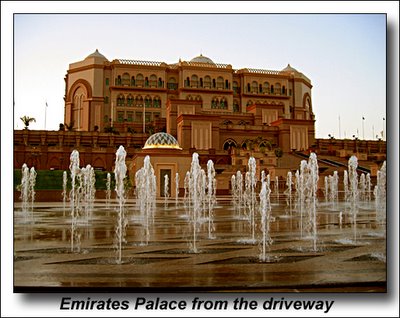
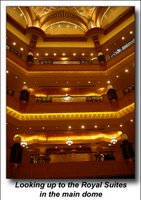 It's main purpose is to serve as a place to host the royal families and heads of state of the GCC countries when they come to visit the UAE, and need a place to rest their weary heads. There's no going in the main entry door for these folks: from the gates at the front 2 corners of the hotel grounds, there's a car access ramp especially for the GCC visitors which puts them into a private Majlis (meeting and welcome) area, after which they are whisked into their suites. Quite rightly too - who would want to mix with the hoi polloi below, who if our palace tour guide could be believed, can spend over Euro 3,000 per night to stay in one of the 'smaller' suites.
It's main purpose is to serve as a place to host the royal families and heads of state of the GCC countries when they come to visit the UAE, and need a place to rest their weary heads. There's no going in the main entry door for these folks: from the gates at the front 2 corners of the hotel grounds, there's a car access ramp especially for the GCC visitors which puts them into a private Majlis (meeting and welcome) area, after which they are whisked into their suites. Quite rightly too - who would want to mix with the hoi polloi below, who if our palace tour guide could be believed, can spend over Euro 3,000 per night to stay in one of the 'smaller' suites.
On our visit in October '05, we were pleasantly surprised to find that the guards at the gate waved us through without making us stop to give us the 3rd degree. They have VERY tall doormen at the front entrance, and we chatted to a couple of them who were from Nigeria and the Philippines. They told us that they were picked for the job based on their height! Every staff member that we encountered was extremely pleasant and helpful, and we were made to feel very welcome. Even when we ventured into areas that were out-of-bounds, the security guards went to great lengths to politely steer us back to where we were officially allowed to be.
J had booked us into Le Vendome Brasserie for lunch. There must have been at least 100 dishes on the buffet tables: there were 5 long benches bowed under the weight of every conceivable dish that you could imagine. It did make us wonder how much food is wasted, as there were only around 20 people in the restaurant, and the amount eaten didn't cause a dent in any of the food.
 After lunch, we signed on for the hotel tour which we were lucky enough to get for free, because we had eaten in the hotel. Our guide was a very pleasant, tall Russian woman who took us on a tour of 3 different sizes of accommodation suites, the gym, the auditorium and the ballroom.
After lunch, we signed on for the hotel tour which we were lucky enough to get for free, because we had eaten in the hotel. Our guide was a very pleasant, tall Russian woman who took us on a tour of 3 different sizes of accommodation suites, the gym, the auditorium and the ballroom.
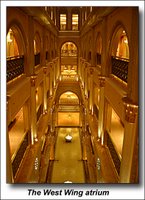 There is a distance of 1 km to walk from one side of the hotel to the other! We were shown suites in the main dome area, as well as in the West Wing of the hotel.
There is a distance of 1 km to walk from one side of the hotel to the other! We were shown suites in the main dome area, as well as in the West Wing of the hotel.
The gym is state-of-the art, as is everything else in this place. All the rooms have the latest electronic equipment - free internet, audio and stereo equipment; with at least one over 50" plasma TV mounted on the walls - some suites had 2 of these: 1 in the lounge and 1 in the bedroom.
You could host a party in the bathrooms, and some suites had dining rooms that could seat small, intimate soirees of about 20 people!
Our tour group did think that the furnishings were a bit bland and neutral for the size of the rooms. It would have been nice to have a splash of bright colour in either the curtains or the bedspreads, instead of all the beige and neutral 'colours of the desert' in which the rooms were decorated.

If the Swarovski family wasn't already rich, then they could surely retire on what was earned from the chandeliers that their company was commissioned to create and assemble for the Palace. Each one was a work of art, and all people on the tour agreed that we wouldn't like the twice-yearly job of hand-polishing every individual crystal in the hundreds of chandeliers that were installed throughout the hotel.
The grounds of the hotel are beautiful. From a distance, we saw a pool that looked like a river which wound its way around islands of greenery. The river had a water current running through it, so the swimmers could either go with the flow, or swim against it. The beach was manicured to perfection, and there were lots of areas to sit in the shade and relax with a cool drink served by the ever-attentive staff.
 With the tour officially over, we were invited to privately walk around the public areas at our leisure, after which we drove back to Dubai; totally bemused at the opulence, richness and grandeur that we had just witnessed.
With the tour officially over, we were invited to privately walk around the public areas at our leisure, after which we drove back to Dubai; totally bemused at the opulence, richness and grandeur that we had just witnessed.
 We left work early on a Thursday afternoon, came home, packed the car and then we were off - driving in heavy traffic through Dubai and Sharjah, before it eased out while continuing through Ajman, Um Al Quwain and Ras Al Kaimah. (Knowing better now, we'll take the Emirates Road all the way to RAK - so much quicker and easier!)
We left work early on a Thursday afternoon, came home, packed the car and then we were off - driving in heavy traffic through Dubai and Sharjah, before it eased out while continuing through Ajman, Um Al Quwain and Ras Al Kaimah. (Knowing better now, we'll take the Emirates Road all the way to RAK - so much quicker and easier!)
This area was all new to M who had only been as far north as Ajman - and it is vastly different to the urban sophistication that is Dubai. UAQ and RAK are much less developed and more rural - although this is bound to change over the next few years. We saw our first on-land oil drilling platform in RAK!
The UAE Dahra/Oman Tibat border proved to be an interesting time - UAE was easy, but the confused Omani military border guard (maybe the sight of 2 women travelling without male companions proved too much for the poor man!) was quickly replaced by a more knowledgeable civilian who took over, typed our names into the computer, (no one would ever be able to find us from what he typed!), stamped our passports and we were free to drive into Oman.
Dusk fell as we drove along the amazing coastline on a beautiful road that had been carved out of the rocky hillsides and reclaimed from the sea. As darkness enveloped us, we reached our destination - Khasab - the stepping stone to the fjords of Oman, and a very quiet little town boasting a fishing port and an airport with a runway as long as the town is deep.
The Esra apartments were clean and basic - just what we needed for 2 nights. We unpacked the car and then got straight back into it to drive back up the coast to the Golden Tulip Hotel for dinner. The Ramadan buffet was delicious - lots of seafood and local delicacies. After dinner, we sat out on the wide terrace to enjoy the warmth and watch the activities of the hotel guests.
Arriving back at the apartment, we were keen to check out the 200 channel satellite TV to see what we could find. There were about 30 Italian channels, 50 Arabic, 30 that didn't work, 2 English (BBC News and music), 10 German (one of us was happy!), 8 French - and the rest were p*rn! We couldn't believe what we were seeing on the screen in a Muslim country!
The 7:30am knock at the door came all too early, but we were dressed and headed up to the rooftop for a breakfast of boiled eggs, cereal, toast, coffee, tea and fruit juice. The apartments were full of people from Dubai, and after breakfast we formed a convoy in our 4WDs behind the travel agent who escorted us to the harbour, where we boarded our dhows for a day of cruising on the fjords of the Musandam.
If anyone wants to go into this region, call Khasab Travel to arrange it. They booked everything for us and gave us all the necessary documentation for the border controls - even instructions on how to get to Khasab from Dubai!

We were lucky - of the 5 dhows that were in the harbour, we reckoned that we got the best. Our skipper was Mohammed and his crewman was also Mohammed! Captain Mo was a modern-thinking Muslim who loved Bob Marley, so we cruised all day listening to the Rasta sounds of BM and the Wailers, interspersed with Arabian music whenever we came closer to the other dhows which were captained by more 'traditional' Omani skippers!

5 mins out of the harbour saw the first of 3 encounters with dolphins. These guys were the biggest that we've seen - some were over 2 meters long and had pronounced humps. The mother and calf were funny as mum was determined to be protective, until baby pushed its way to be closer to the dhow to get the best ride on the wave. It was beautiful to watch these gorgeous creatures effortlessly surfing the waves and keeping pace, often jumping sideways out of the water to look at us through one eye.
Cruising into Khor Ash Shamm was awe-inspiring and we were all very quiet as our eyes struggled to take in the incredible scenery and apply some sense of scale to what we were seeing. Huge cliffs and mountains soared into the sky straight out of the water. 'Khor' is Arabic for fjord, and the tourist marketing likens them to the Norwegian Fjords. All M could think of was that it was a bigger Milford Sound with wider water - there was even a mountain shaped like Mitre Peak!
 In the company of other dhows, we cruised around the fjord as Mohammed told us some of the history of the villages and the other sights that we were seeing. Sometimes the scenery battled for supremacy - dolphins, mountains, villages, turtles, stingrays, other dhows - it was a visual assault!
In the company of other dhows, we cruised around the fjord as Mohammed told us some of the history of the villages and the other sights that we were seeing. Sometimes the scenery battled for supremacy - dolphins, mountains, villages, turtles, stingrays, other dhows - it was a visual assault!
Although known to the local Omanis, Khor Ash Shamm was discovered by the British in 1820. In the khor is Telegraph Island which was a manned British communications station between 1864 and 1869. The cable stretched from India, through Oman and into neighbouring countries westwards until it reached England. It was the principal line of communications between Mother England and the Indian colonies. The building foundations are still visible, and the whole island is surrounded by coral and tropical fish which makes it a popular spot for the dhows to anchor, and let their passengers jump overboard to explore the undersea life.


Of course, we did just that! We even did our bit for conservation when we found a fish pot full of reef fish. We untied it and let the inedible and smarter reef fish go free, while the dumber edible fish like the hammour stayed in the pot, as if resigned to their fate! M tried out her new underwater housing for her Canon, and although the water was silty she managed to get some reasonable shots. As the day drew to an end, we cruised out of the khor and headed back to Khasab, pausing for another brief swim and snorkel on the way.
After a quick shower back at the apartment, we headed up the Wadi Sal Al A'la valley behind Khasab for a look at the only accessible-by-road fjord - Khor Najd. We briefly hesitated before going up the road to the fjord, as there were military warning notices telling people not to enter the area because of target practice! Once we had established that they meant the fenced area behind the sign, we continued onwards and upwards. Wow - the road up was incredible, the road down the other side was a rally driver's dream, and the view of the fjord at dusk was spectacular.
 We were blown away, and just stared at the scene until lack of light and hunger made us think about dinner. It was back to the only restaurant in town at the Golden Tulip Hotel. Inspired by what we had already seen, we were really looking forward to the next day's travels further up into the Hajjar mountains behind Khasab.
We were blown away, and just stared at the scene until lack of light and hunger made us think about dinner. It was back to the only restaurant in town at the Golden Tulip Hotel. Inspired by what we had already seen, we were really looking forward to the next day's travels further up into the Hajjar mountains behind Khasab.
8am the next morning saw us again having breakfast on the rooftop, and this time we were entertained by the airport staff using a road sweeper to clean the incredibly long runway at the little airport, and by a military helicopter that took off and soon looked insignificant as it disappeared over the mountains on its way to Muscat. Just as we hit the gravel road heading out of town into the Wadi Sal Al A'la valley, we saw the reason for the airport activity. With all landing lights ablaze, coming towards us over the mountains was a military Hercules C-130 transporter plane. We stopped to admire the pilot's skills as he skimmed over the mountains, dropped into the valley, turned sharp right, lined the plane up with the runway and made a perfect landing. Now we knew the reason for the long runway: heavy military planes!
Soon we were leaving the flat valley floor and climbing the first of many steep inclines into the Hajjar mountains. This mountain range is like a spine that runs the entire length of Oman, in roughly a north to south direction. We were at the very northern tip. M was a little cautious at first, as this was the first gravel trip in the Honda MRV 4WD. It continues to impress us as a practical and reliable vehicle, and the V6 engine and torque make it an ideal offroad and gravel traveller, as well as being safe and comfortable to drive in the city.
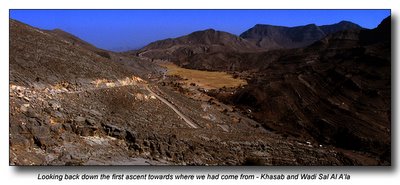
 After the first climb of a couple of thousand feet, we ran out of superlatives to describe the scenery that we were seeing around every corner, and were reduced to silent, wide-eyed wonder as we absorbed the beauty of our surroundings.
After the first climb of a couple of thousand feet, we ran out of superlatives to describe the scenery that we were seeing around every corner, and were reduced to silent, wide-eyed wonder as we absorbed the beauty of our surroundings.
There were small uninhabited villages, (the people live on the coast in Summer and return to the mountain homes in Winter), built into seemingly impossible terrain, and the natural rock formations and vegetation features were awesome.

We could see areas where the water must run down the mountains and over the roads during Winter. It must be truly spectacular to see this, as well as a little scary too, as it would most likely wash away the road, and anything else in its path.
We encountered very few people as we drove along. The local Omanis were incredibly friendly - waving and calling out greetings - even the women in full abayas and face pieces (we have yet to find out what these are called) would wave to us. The tourists were less friendly, barely managing small greetings, and we saw a few white-knuckled, pale-faced drivers as they navigated the gravel roads!

Sayh Plateau was at the very top of the steep climb up the northern face of the mountain range. It's 1800 metres above sea level, and is a farming area and settlement. In Winter, it looks like a green lake with all sorts of crops such as alfalfa, wheat, radishes and onions. It was largely uninhabited and very brown as we drove through. The people had yet to move back from the coast.
It was strange seeing empty houses, and thinking that people are so trusting - and trustworthy - that properties can be left uninhabited and not broken into. Try leaving a whole village abandoned in most western so-called 'civilised' countries and see what happens!
Climbing out the other side of the Sayr Plateau saw the vegetation start to change from what we had been seeing. There were more greener low-lying scrub plants, and it looked very different to the rocky cliffs that we had experienced on the ascent to the plateau. The terrain was now more hilly than mountainous, and this continued for a while as we climbed up to the highest point on our journey, and in the Musandam - Jabal Harim. We could see it towering above us for quite some distance - very distinguishable by the huge 'golfball' structure on the 2,087m summit. This was obviously a communications post of some sort, and as we got closer to the top, the warning signs against trespassing into military zones made us think that it was a strategic Omani listening post - perhaps also associated with the UAE military. We received friendly waves from the gun-toting guards as we passed the gate, and we were careful to pass out of sight and hearing before we stopped the MRV at the top of the road to take photos of where we had come from, before driving on to drop down the other side.
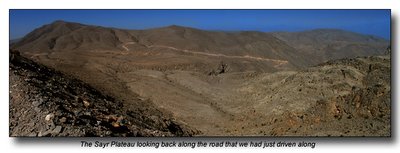 If you're still reading - good on you!
If you're still reading - good on you!
Nothing could prepare us for what we saw on the other side of Jabal Harim - suffice to say that we felt the Grand Canyon tremble in its boots at the competition. Unlike the GC with its multitude of visitors, this place was largely deserted and absolutely silent. We knew that there were people in the listening post behind us, and we could see a 4WD on the long plateau way below us - but it was so quiet, and the silence lent to the grandeur and beauty. We felt as if we had been beamed to another planet. In the below image, you can see the terraced farming areas where winter rains are trapped for the cultivation of crops and for livestock drinking water. Water for human consumption is trucked in, and the Omani government pays for all water supplies to the Omani people. Very cool, that! We passed many water tanks at the tops of tracks that led to dwellings whose inhabitants depended on the water deliveries from the sweet-water wells on the low-lying areas closer to the ocean.
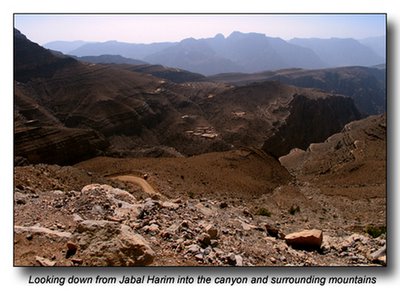 Of course, we had to take another shot of our beloved 4WD - we felt as if we were in a photo shoot for Honda!
Of course, we had to take another shot of our beloved 4WD - we felt as if we were in a photo shoot for Honda!
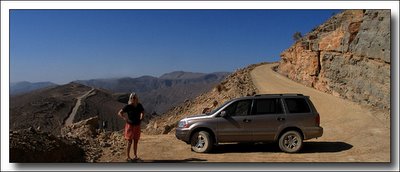 It was getting to the point where we couldn't turn a corner without another photo opportunity. We wound our way along the track, heading for the Rawdah Bowl at the bottom of t
It was getting to the point where we couldn't turn a corner without another photo opportunity. We wound our way along the track, heading for the Rawdah Bowl at the bottom of t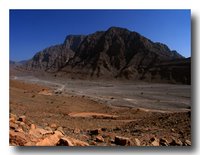 he mountains. The vegetation had again changed and we were now seeing lots of thorny Acacia trees as well as the usual low-lying shrubs.
he mountains. The vegetation had again changed and we were now seeing lots of thorny Acacia trees as well as the usual low-lying shrubs.
As we stopped the Honda for another photo, another 4WD rumbled to a halt beside us. In it was a delightful Omani man who proceeded to have an animated conversation with M - he in Arabic and she in English! Neither had a clue what the other was saying, but it went on for a couple of minutes with the only recognisable word to M being 'Khasab' - to which she nodded! When M held up her camera,  he stopped talking so that she could take his picture. Then, after she uttered 'Shukran' (thank you) to him, (one of the very few Arabic words that M does know!), he was off with a friendly wave and in a cloud of dust. It made us both smile from ear to ear - and we felt happy and lifted from the encounter - it was all good!
he stopped talking so that she could take his picture. Then, after she uttered 'Shukran' (thank you) to him, (one of the very few Arabic words that M does know!), he was off with a friendly wave and in a cloud of dust. It made us both smile from ear to ear - and we felt happy and lifted from the encounter - it was all good!
Following the old man's vehicle, we suddenly came across the Omani/UAE border control point as we left the Rawdah Bowl. Beyond the barrier, the road forked and to the right was the road to Ras Al Kaimah. To the left was the road to the port of Dibba, which is half Omani, half UAE territory, and on the east coast of the peninsular. We had travelled 58 kilometres from Khasab - roughly half the distance to Dibba.

The old man and his truck were waved across the border like old friends, but we were a different story. We had been warned that we may be turned back and have to return the way we came, and after our passports were inspected at length by 2 friendly, smiling border guards and 1 guy dressed in civvies who could speak a little English, we were indeed asked to return to Tibat where we had crossed over. We have decided that we also have to do the road to the border from the Dibba end, as what we had seen so far was truly beautiful, and had left us eager for more adventure.
On the way back, we further explored the Rawdah Bowl and turned off the main road into a valley that led to a small town with an equally small airstrip. We waved to the teams of Indian powerline workers who were up the poles and polishing the ceramic conductors! We came across a very picturesque cemetery with a tiny mosque that was towered over by the mountain guardians.
 The access road in and out of the valley ran smack in the middle of the flat ground, with beautiful rugged mountains towering each side. It was a very spiritual place and M felt the eyes of a million years upon her, as she stopped for photos, and a pee behind a large rock!
The access road in and out of the valley ran smack in the middle of the flat ground, with beautiful rugged mountains towering each side. It was a very spiritual place and M felt the eyes of a million years upon her, as she stopped for photos, and a pee behind a large rock!
 The journey back to Khasab was faster because of the familiarity with the road; less frequent photo stops; M getting used to the Honda on gravel. J didn't think much of her 'intentional' attempts to hit every rock with the right-hand wheels, but what did she expect on a gravel road? To be fair, M was also hitting rocks with the left-hand wheels, it's just that J couldn't feel those ones when sitting on the right!
The journey back to Khasab was faster because of the familiarity with the road; less frequent photo stops; M getting used to the Honda on gravel. J didn't think much of her 'intentional' attempts to hit every rock with the right-hand wheels, but what did she expect on a gravel road? To be fair, M was also hitting rocks with the left-hand wheels, it's just that J couldn't feel those ones when sitting on the right!
We drove back to the Omani/UAE border and passed through with ease - heading back to Dubai with a detour into Um Al Quwain, where neither of us had been before. It sure is quiet there, in comparison to Dubai! We can now say that we've driven through the main towns in all 7 emirates that comprise the UAE.
Our next adventure will be to tackle the gravel track from Dibba to Ras Al Kaimah without crossing over the Omani border when we go to Fujairah (Dibba) for a day of diving in the Musandam. There will also be a 4 day excursion into Oman on the east coast, to visit Muscat in December.
Interspersed with the various road trip stories, we'll be posting experiences from our time spent in other countries as well as times in Dubai and the UAE. We hope that it's interesting enough to make you come back now and then to read more of what we're up to.
A warning to all of our friends and family who stop to stay with us over a weekend or two - we'll be taking you on at least one of these adventures! There's so much to see and do in this part of the world, and now that we're spending less time in planes travelling on business and more time in Dubai, we have lots of chances to explore the region. It's fun, and gives us a break from the anonymous entity that is Dubai. Travelling to lesser developed areas proves to us that this country does have an old soul, spirit and friendly people, and is not all about marketing hype, stress and glitzy facade.
It makes us feel alive!
 We're in Tokyo until Saturday afternoon on business. Thankfully, yesterday was a holiday here - Thanksgiving Day. It's not like the USA holiday - it's about giving thanks to the bread-winners in the family: those who pay the bills. We were thankful too - it gave us a day off!
We're in Tokyo until Saturday afternoon on business. Thankfully, yesterday was a holiday here - Thanksgiving Day. It's not like the USA holiday - it's about giving thanks to the bread-winners in the family: those who pay the bills. We were thankful too - it gave us a day off! e also walked through our favourite shrine right next door to the hotel - the Hie Shrine. The shrine is a Shinto place of worship, and its history has been marked with violence: the buildings have been burned down twice, but the place is still so calm and peaceful and we love it.
e also walked through our favourite shrine right next door to the hotel - the Hie Shrine. The shrine is a Shinto place of worship, and its history has been marked with violence: the buildings have been burned down twice, but the place is still so calm and peaceful and we love it. t of fashion with the women! Some of the schoolkids riding the trains don't look old enough to be in school, yet here they are navigating the train system with the experience of people 5 times their age. They are so cute in their uniforms and hats!
t of fashion with the women! Some of the schoolkids riding the trains don't look old enough to be in school, yet here they are navigating the train system with the experience of people 5 times their age. They are so cute in their uniforms and hats!
